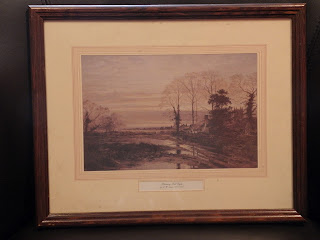Today was a quiet day, spent moving miscellaneous items into the study and framing pictures. I mounted and framed three old maps, which were taken from a set of Cassell's Popular Educator inherited from my maternal Grandfather.
John Cassell was one of those most extraordinary of Victorians. Born in Manchester in 1817, his family descended into grinding poverty following the death of his father. In an attempt to better himself, John apprenticed himself to a carpenter. During his indenture, he became involved in the temperance movement, and when his time was served, he decided to become a peripatetic temperance lecturer. In 1836 he walked, in sixteen days, from Manchester to London, arriving with three pence in his pocket. In the capital he became very involved in temperance work, and whilst on a pro-nephalistic lecturing tour of Lincolnshire in 1841, he met his future wife, Mary. She inherited a sum of money from her father, which allowed John to set himself up in business, as a tea and coffee merchant. In order to advertise his wares, he bought a second-hand printing press, which he also used to print his self-penned temperance tracts. He went into partnership with his brother-in-law, giving himself more time to concentrate on his writing, and he began to publish works intended to help the working classes become better educated. In 1852 he began his Popular Educator, published in weekly parts and described as "... a school, a library and a university". It was widely recognised as being responsible for raising the level of education throughout the country. Cassell went on to publish many other works, including illustrated editions of classic novels. He died, at the early age of 48, from a tumour. Cassell's publishing house continued to issue works after the death of the founder.
My grandfather,Thomas William, was one of the auto-didactic working men who benefited from the Popular Educator. His 64 weekly-part edition is dated 1910, and cost 3d. per issue (the very sum John Cassell arrived with at London). I trace my own love of books directly back to him. The first map is of The World - in 1910 - thus predating the Great War. It also has vast swathes of pink, denoting the British Empire.
The second map is England and Wales, when England and Wales had proper counties. And Rutland - proper Rutland that is. And Cumberland and Westmorland, none of your Cumbria nonsense. And Northumberland. Proper counties.
The third map is India and Ceylon. Still part of the Raj, don't you know, in those days. Before partition, independence and so on. Ceylon is post-Serendip, but pre-Sri Lanka. Serendip is the root of the word serendipity. This means the happy accident of finding something good or useful without looking for it. It is also one of the ten most difficult words to translate from English into another language.
Here are the picture frames with their original pictures. They cost a
pound each, from a charity shop in Barnoldswick. I think they look
better now.







No comments:
Post a Comment